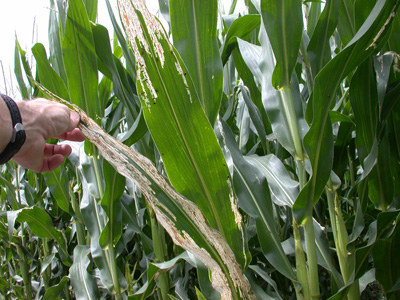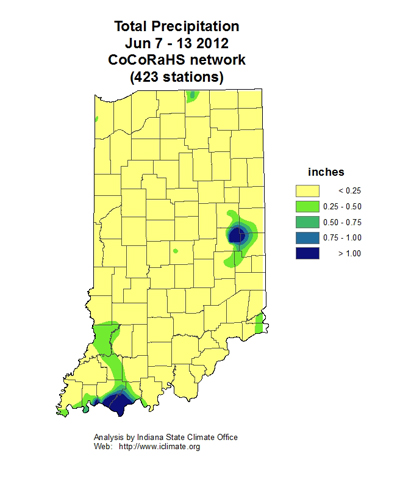Pest & Crop Newsletter, Entomology Extension, Purdue University
No Surprise, Spider Mites Responding to Dry Conditions and Stressed Soybean - (Christian Krupke and John Obermeyer)
• Spider mites can now be found in some of the driest soybean fields.
• Stressed areas of fields (especially edges) will show damage first.
• Consider many factors before treating for spider mites.
• Products for spider mite control is limited, and should be carefully selected.
According to the U.S. Drought Monitor (<http://droughtmonitor.unl.edu/pics/in_dm.png>), as of June 12, 88% of Indiana is abnormally dry, with 39% of that in the first stages of drought. It should come as no surprise that two-spotted spider mites have just begun to move into and colonize thirsty soybeans. Iowa and Ohio have reported the same in their pest newsletters over the last week or so. Foliage damage from spider mite feeding is expressed initially as subtle stippling, which may progress to a bronzing and necrosis should dry conditions persist and mites are left unchecked. Bronzed foliage is irreversible, meaning the damage is done!
The beginnings of a spider mite infestation at a field's edge
Before considering control, it is very important that spider mites are identified as the source of yellowish or bronzed plants in a field. Note that there are many other diseases, pathogens and nutrient deficiencies that cause a similar appearance of foliage. To confirm the presence of mites, shake some discolored soybean leaves over a white piece of paper. Watch for small dark specks moving about on the paper. Also look for very tiny, fine webbing on the undersides of the discolored leaves. Once spider mites have been positively identified in the damaged areas of the field, it is essential that the portions of the entire field be scouted to determine the range of infestation – spider mites are very patchy in colonizing fields – many times beginning at the borders. Sample in at least five different areas of the field and determine how far the spider mites have moved into the field from the grassy borders by using the “leaf-shake” method.
Spider mite damage moving into a field
Stippling from spider mite feeding
Mites are found in every field, every year. In most years they are held in check by a combination of predators, and the soybeans are healthy enough that mites are not able to build up populations to a high level. However, stressed plants actually provide a more nutritious feast for spider mites than healthy plants do, and in particular make amino acids available to the mites. This means protein, which is what mites use to make – you guessed it – more mites! Thus they thrive and quickly colonize large areas or fields where stress is more evident. Sandy, high clay, or compacted soils will exacerbate moisture stress in plants, with or without the presence of spider mites. Other stresses on soybean include pests such as soybean cyst nematode, root diseases, or nutritional imbalances, such as manganese deficiency. Obviously the best plant stress reliever under dry conditions is rain. Significant rain doesn’t control spider mites but helps the soybean plant become more vigorous and healthy. This, in turn makes the “juices” of the plant less nutritious to the mites, and makes mites less likely to reproduce as quickly.
The most severe damage occurs when the infestation starts in the early stages of plant growth and builds throughout the season (extended drought). Before applying controls carefully consider that, depending when damage is noted, multiple insecticide/miticide applications may be necessary. This is because surviving spider mites are able to repopulate a field much more quickly than their natural predators, which are usually also wiped out by these chemical applications. If leaf discoloration is apparent in multiple areas of the field, spider mites are positively identified as the culprit, and hot, dry conditions are expected to persist, it is recommended that a control be considered.
If a control is warranted, two pesticides are recommended for use. These include dimethoate (multiple generic formulations are available) and chlorpyrifos (Lorsban 4E and generics). Dimethoate is the most efficacious of these compounds for mite control. Neither of these products will control spider mite eggs, however, and each will provide a maximum of 7 days of residual activity. Proper placement of these pesticides is the key to successful control results. Nozzle pressures of 40 psi with fine to medium droplet size and 30-40 gallons of water per acre for ground application helps distribute the pesticide throughout the foliage. There are several products on the market with a combination of chlorpyrifos and synthetic pyrethroids. At this time we cannot recommend them, as field data for their efficacy for twospotted spider mites is limited. In general, do NOT use synthetic pyrethroid products when spider mites are present in fields, as they kill the natural predators and many perform poorly against mites.
Watch this You Tube video on spider mites.
![]()
Western Corn Rootworm Beetles Emerging…Already! - (Christian Krupke and Larry Bledsoe)
• Western rootworm adults have been spotted in west central Indiana.
• Beetles should not be a concern until fields are pollinating.
• Late planted/replanted fields could be a “trap crop” for beetles and egg laying.
Western corn rootworm beetles were captured in Tippecanoe County traps early this week. Just like the larval hatch, the beetles are 2-3 weeks earlier than normal. The male beetles are generally first to emerge and feed for several days until females begin emerging a few days later. Females mate, then feed and disperse, sometimes over long distances.
Adult beetles survive for several weeks and are consistently attracted to pollen sources throughout their lifespan. Therefore, late-planted fields are particularly susceptible to silk-clipping, although rootworm populations have been very low in Indiana for several years and we have not seen populations sufficient to clip silks.
Western corn rootworm beetle leaf feeding
![]()
Click here for the Blacklight Trap Catch Report
Click here for the Western Bean Cutworm Trap Report
![]()
Weed Control Considerations of Double Crop Soybeans – (Travis Legleiter and Bill Johnson)
Harvest of winter wheat in Indiana has officially started in the southern regions with about 8% harvested last week and we expect that number to increase rapidly in the next couple of weeks. This past week I witnessed something that mildly bothered myself as a weed scientist. The efficiency of todays agriculture machinery was on display as two combines finished off a wheat field with a 24 row soybean planter pulling into the field to quickly get the ground back into production. The thing that bothered me was the amount of living, green, marestail and ragweed plants sticking up in the wheat stubble getting ready to take full advantage of the newly opened canopy and much younger soybean seedlings soon to emerge. Now this is all under the assumption that there wasn’t a sprayer down the road filling up with herbicide getting ready to do a burndown application following the planter.
This may not be the case in all wheat fields, but producers need to be aware of summer annual weeds hiding under the mature wheat canopy, and be prepared to control these weeds early. Weed scientists at Purdue strongly recommend starting with a weed-free seedbed regardless if we are growing full-season or double crop soybean. it is especially important to control marestail and giant ragweed prior to soybean emergence. Another issue that we have received calls on in the past couple of weeks has been uncontrolled winter annual grass, such as annual ryegrass in winter wheat. The following will cover some recommendations on how these weeds should be handled going into double crop soybeans.
Marestail and Giant Ragweed
These are two weeds that can be difficult to control with postemerge soybean herbicides, especially if the population is resistant to glyphosate. So it is important that producers recognize if these weed species exist as weeds following wheat harvest, the density of the weeds, and past history of glyphosate resistance in the field. Whether the population is resistant or susceptible, producers should still plan on doing a burndown on fields with high densities of these two weeds. A recommended burndown that would not require a planting restriction would be glyphosate plus sharpen. Unfortunately, there are not any residuals for marestail and giant ragweed that are safe to rotate to corn in 10 months, besides metribuzin (Sencor). Metribuzin will provide residual activity on marestail, but not much on giant ragweed. It will be much easier to control these weed species prior to soybean emergence, rather than waiting to control 12” plus weeds post-emerge with the few options of glyphosate or PPO inhibiting herbicides or Liberty in Liberty Link soybeans.
Winter Annual Grasses
This is likely much less of problem in much of Indiana, but I know I have gotten a couple of calls and will pass on the recommendation that were given to those producers. The specific issues I have encountered were annual ryegrass and little barley that were not controlled in the wheat crop. Both of these species are known winter annuals, but can also persist and/or emerge in double crop soybeans. At this point in the season, it is obviously too late to keep these species from adding seed to the seed bank. Although steps can be taken to keep these species from competing into the soybean crop with a burndown using high rates of glyphosate (≥1.25 lb ae/A) to control any grass that has not yet matured, plus a grass residual such as Dual II Magnum or Outlook to keep any additional plants from emerging in the soybean crop.
![]()







